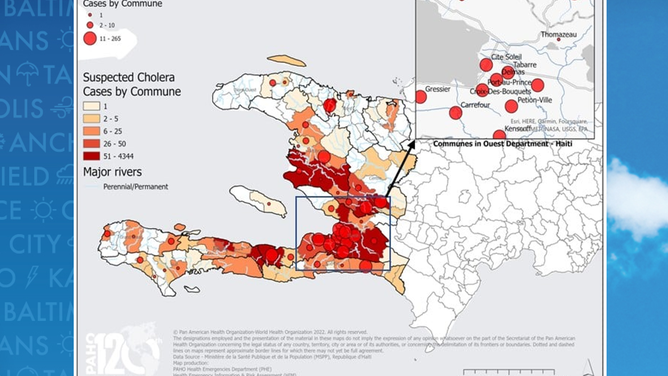Haiti crisis plunges country into extreme vulnerability to natural disasters
Over the last two decades, hundreds of thousands of residents have been killed in earthquakes, flooding and hurricanes. A magnitude 7.0 earthquake that struck the nation on Jan. 12, 2010, is considered to be the country’s deadliest event, with over 200,000 people who were killed and damage estimates that topped more than $7 billion.
Crisis in the Caribbean nation of Haiti could lead to more vulnerabilities to weather disasters
FOX News' Gillian Turner reports from the U.S. State Department on conditions in Haiti amid a growing crisis.
PORT-AU-PRINCE, Haiti – A crisis involving armed gangs and anti-government factions threatens to further destabilize the poorest nation in the Western Hemisphere that not only relies on aid for daily life but for responses to natural disasters.
The destabilization of government entities in the Caribbean nation has increased ever since the assassination of President Jovenel Moise in July 2021 and led to the recent resignation of the country’s prime minister.
The United Nations Office for the Coordination of Humanitarian Affairs reports life-saving humanitarian assistance and transportation across the country’s capital has virtually come to a halt as the official government has grown powerless.
The state of affairs is of concern to aid groups, who are regularly called on to help support the more than 11 million residents.
"The situation in Haiti is heartbreaking. Tens of thousands of people have been forced to flee for their lives as gang violence in Port-au-Prince spreads to other areas," Allen Speer, CEO of Agape Flights, said in a statement.
The Florida-based group is a donor-supported Christian aviation ministry that has delivered aid in the Caribbean for decades but has suspended operations in Haiti because of the violence.
The country’s lawlessness, terrain, poor infrastructure, and economy make it one of the most susceptible to natural disasters, which are common on the island of Hispaniola.
Since 2000, more than a dozen significant events have impacted the nation, killing hundreds of thousands of residents and leaving millions homeless.
Flooding, earthquakes and hurricanes are among the most frequent weather disasters, but journal publications say preparations are often underwhelming.
ANTARCTICA’S ‘DOOMSDAY GLACIER’ IS MELTING AWAY DIFFERENTLY THAN SCIENTISTS FIRST THOUGHT
Year-round earthquake threat
Haiti and the neighboring Dominican Republic lie between two plates, making the region a hotbed for tremors, with many that have been significant.
According to data from the U.S. Geological Survey, the primary strike-slip type fault, known as the Enriquillo-Plaintain Garden Fault, has produced quakes with magnitudes greater than 8.0, which are capable of widespread destruction.
A magnitude 7.0 earthquake struck the nation on Jan. 12, 2010, and is considered to be the country’s deadliest event, with over 200,000 people killed. Damage estimates topped $7 billion, with over 1 million people who became homeless.

USGS topographic map
(USGS / FOX Weather)
A little more than two years later, a powerful 7.2-magnitude quake is estimated to have killed over 2,000 people, with many more that were forced out of their homes.
The more powerful of the two earthquakes was credited for doing far less damage because of its distance from the all-important city of Port-au-Prince.
The 2021 event was centered about 78 miles west of the capital city, while the 2010 quake was only about 15 miles away.
A lack of building codes ensures that structures composed of bricks and stones are often impacted by even the weakest of earthquakes.
ACCESS TO REMOTE LEARNING, TELEMEDICINE DURING EXTREME WEATHER EVENTS COULD END FOR MILLIONS
Hurricane alley
Due to the island’s location near the 20th parallel north of the equator, the region known as the Great Antilles sits in the most vulnerable location for tropical cyclones in the Atlantic basin.
Water temperatures year-round are sufficient enough to support these storms, which can be catastrophic in a county where more than two-fifths of the population relies on farming.
According to the National Hurricane Center historical database, 106 cyclones have passed within a distance of 40 miles or less from the nation.

Paths of tropical cyclones within 40 miles of Haiti
(NHC / FOX Weather)
Some of these events were rather strong and led to the deaths of thousands.
In 2016, Hurricane Matthew made landfall as a Category 4 cyclone with sustained winds around 145 mph.
The UN reported communities to the southwest of the capital were devastated with over 30" of rain in the mountainous regions and at least 600 were pronounced dead.
Some years, the nation doesn’t just deal with one or two storms - in 2008, cyclones pounded Haiti, causing a death toll that reached above 1,000.
A result of many of these disasters was an increase in cholera, which, according to the Centers for Disease Control and Prevention, is a diarrheal infection caused by ingestion of contaminated food or water.
The CDC reports that after the catastrophic earthquake in 2010, more than 800,000 cases were observed, with around 10,000 deaths.
"Improving Haiti’s water and sanitation infrastructure, strengthening cholera surveillance, and targeted use of oral cholera vaccine are key," health officials stated after the historic outbreak.

Geographical distribution of suspected cholera cases in 2022
(Haiti Government/WHO / FOX Weather)
